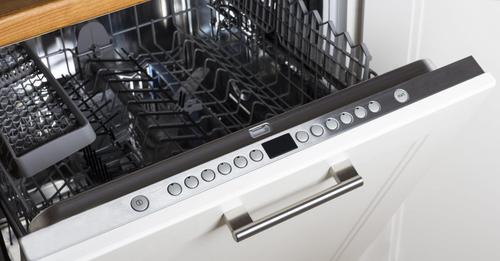We’ve already covered what you should never put in your dishwasher—but are you aware of the many unexpected items you can put on its magical racks? Not only can it sanitize your glassware, it can also clean the heck out of other household items and personal gear you may not be washing enough, either because you’re not sure how or because it’s a time-consuming hassle.
Enter the sturdy, reliable, under-appreciated workhorse that is your dishwasher. From hair products to footwear, metal spades to grimy stove parts, you deserve to know the varied items your Maytag can tackle besides those dinner plates. Prepare to be amazed—and do a lot less dusting.
Broom and dustpan
Not the entire broom—just the foul bristles caked up with the dust, follicles, and sticky oatmeal pieces of 1,000 spilled breakfasts. The part that you never want to touch but know you must, periodically. After removing excess dust and hair to prevent a clog, unscrew it from the handle and plop it in the dishwasher, along with the dustpan. (So long as the bristles are made of plastic, not natural fiber.)
Other cleaning tools
Floor brushes, dust buster parts, vacuum attachments, grill brushes, even your dish drain could all benefit from a cycle through your dishwasher. Most dishwasher manufacturers aim for water between 120 and 145 degrees Fahrenheit. Use a cold water setting if you’re worried about any potential warping.
Range hood filter, grates, and drip pans
Range hood filters that see any kind of regular use are typically full of trapped grease, grime, and dust. In between replacing the filter (which is recommended every one to three months), it can be washed on the top rack of your dishwasher—along with stove knobs, and hard-to-clean burner grates and drip pans.
Light fixtures
Next time you’re about to fire up the Windex to wipe down your favorite dusty, buggy light fixture, remember: You have a dishwasher! And rather than oh-so-delicately circling those globes (all while wondering, Are these securely fastened enough to not fall and shatter right here, right now?) simply unscrew and place them on the top rack of your dishwasher. Wash in a gentle cycle and hand dry before re-attaching.
Plastic toys
If you’ve got small children, the dishwasher is a grand place to chuck all their germy plastic toys for a run-through once in a while (especially after they’ve been sick). Secure small objects in a mesh laundry bag, and avoid washing any hollow toys with holes that might let in water, which will lead to mold growth. (The same goes for plastic pet toys; just leave out any ropes or hides.)
Sponges (and washcloths)
It goes without saying, sponges are nasty and must be cleaned regularly. You can microwave them, soak them in bleach, or toss them in your dishwasher on the hottest setting. Place them in the silverware basket to keep them in place through the soapy blast. You can do the same with dish cloths, if you don’t have enough to run a full load in your washing machine.
Bathroom items
Your plastic wastebasket, shower caddy (metal or plastic), shower door squeegie, hairbrushes, headbands, combs, plastic barrettes, and makeup brushes (so long as they don’t have wooden handles) can all be added to your dishwasher for easy cleaning.
Sports gear and footwear
Knee pads, elbow pads and sweaty shin guards are all dishwasher-safe, as are flip flops, Crocs, canvas sneakers, and rubber boots. Remove the shoe liners first, and replace dishwashing detergent with baking soda for extra funk removal. Don’t use the dry setting on your washer; allow all items to air dry.
Gardening tools
When those trowels, hoes, and compost scoopers start looking like they live in a dirt ditch, forego the hand-scrubbing and put them through a dishwashing cycle. Be sure to dry them to avoid rust. As with any substance you’re not feeling excited to wash alongside your dishes (see funkadelic shoes above), run a short empty cycle between loads to purge the dirt, sweat, and your heebie jeebies. (If you’re concerned about wasting water, each cycle uses less of it than you think.)










